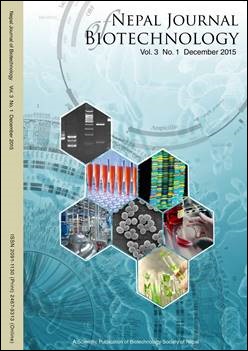Accumulation of Poly-hydroxy-butyric Acid (PHB) by Bacillus Strain Isolated from Paddy Field of Kathmandu University Premises
DOI:
https://doi.org/10.3126/njb.v3i1.14221Keywords:
Polyhydrooxybutyrate, Cell dry weight, Nutrient limitation, biodegradable, bioplasticAbstract
In this study, the effect of applying nutrient limitation on the production of Poly-hydro-oxy-butyric acid (PHB) from soil bacteria was examined. PHB is a biodegradable polymer which provides a reserve of carbon and energy. PHB was extracted by chloroform dispersion method. The amount of synthesized PHB was determined as crotonic acid by spectrophotometry. We found that Nitrogen limiting condition stimulated PHB accumulation. The highest level of PHB accumulation was observed in DNB-6 strain which accumulated 31 % of the dry mass at 20 % glucose concentration. The probabilistic identification of bacteria by PIBwin software version 1.9.2 showed that the strain DNB-6 was close in nature to Bacillus cereus.
Nepal Journal of Biotechnology. Dec. 2015 Vol. 3, No. 1: 2-5
Downloads
1278
1230
Downloads
Published
How to Cite
Issue
Section
License
Copyright Notice:
The manuscript submitted to NJB must be an original contribution, not previously published and should not be under consideration for publication elsewhere. When the manuscript is accepted for publication, the authors agree to automatically transfer the copyright of the article to the publisher. It should grant permission to any third party, in advance and in perpetuity, the right to use, reproduce or disseminate your article, according to the NJB copyright and license agreement.
Authors transfer copyright to the publisher as part of a journal publishing agreement but have the rights to: Share their article for Personal Use, Internal Institutional Use and Scholarly Sharing purposes, with the NJB applies the Creative Commons Attribution-NonCommercial CC BY-NC license to all the works we publish after Jun 2020 (Before it was CC BY-NC-ND). Under this license, authors agree to make articles legally available for reuse, without permission or fees, for virtually any non-commercial purpose. Anyone may remix, adapt, and build upon your work non-commercially, and although their new works must also acknowledge you and be non-commercial, they don’t have to license their derivative works on the same terms. More details on CC BY-NC refer to its Licence Deed and Legal Code.






